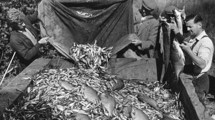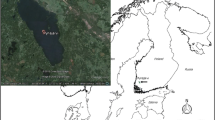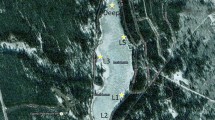Abstract
Lake Apopka (Florida, USA) changed in 1947 from being a clear, macrophyte-dominated lake, used primarily for fishing, into a turbid algal lake with a poor fishery. The lake has resisted various efforts to reverse the change and restore the previous state. The restoration approach emphasizes the reduction in phosphorus inputs to reduce algal blooms and clear the water. We examined the question of whether a deep-lake approach with nutrient reductions is going to work on this large (area 124 km2) and shallow (mean depth 1.7 m) lake, or if techniques such as drawdowns or wind barriers developed for shallow lakes using the theory of alternative stable states are more applicable.
The assumptions upon which the current restoration is based are not supported. The poor transparency is due more to resuspended sediments than plankton algae, so the current Secchi disk depth of 0.23 m is predicted to increase to 0.34 m with any reasonable reduction in algal levels. The failure of the macrophytes to become re-established probably is due more to unstable sediments than lack of light reaching the lake bed, and the marsh flow-way developed by the St Johns River Water Management District will be ineffective in removing particles from the lake. It would take more than 300 years to remove the fluid mud and more than 800 years to remove the rest of the low density sediments. We conclude that the loss of macrophytes in Lake Apopka is an example of a forward switch in the theory of alternative stable states, and that it will take more than a nutrient reduction program to bring about the reverse switch to a macrophyte state. We suggest an alternative approach using wave barriers to create refuges for plants, macroinvertebrates, and fish to restore Lake Apopka's largemouth bass fishery.
Access this article
We’re sorry, something doesn't seem to be working properly.
Please try refreshing the page. If that doesn't work, please contact support so we can address the problem.
Similar content being viewed by others
References
Andersen, F. Ø. & E. Lastein, 1981. Sedimentation of resuspension in shallow eutrophic Lake Arreskov, Denmark. Verh. int. Ver. Limnol. 21: 425–430.
Appleby, P. G. & F. Oldfield, 1978. The calculation of lead-210 dates assuming a constant rate of supply of unsupported 210Pb to the sediment. Catena 5: 1–8.
Balls, H. R., B. Moss & K. Irvine, 1989. The loss of submerged plants with eutrophication I. Experimental design, water chemistry, aquatic plant and phytoplankton biomass in experiments carried out in ponds in the Norfolk Broadland. Freshwat. Biol. 22: 71–87.
Bannister, T. T., 1974. A general theory of steady state phytoplankton in a nutrient saturated mixed layer. Limnol. Oceanogr. 10: 13–30.
Bengtsson, L. & T. Hellström, 1992. Wind-induced resuspension in a small shallow lake. Hydrobiologia 241: 163–172.
Blindow, I., G. Andersson, A. Hargeby & S. Johansson, 1993. Longterm pattern of alternative stable states in two shallow eutrophic lakes. Freshwat. Biol. 30: 159–167.
Brezonik, P. L., C. D. Pollman, T. L. Crisman, J. N. Allinson & J. L. Fox, 1978. Limnological studies on Lake Apopka and the Oklawaha Chain of Lakes I. Water quality in 1977. Report No. ENV–07–78–01, Department of Environmental Engineering Sciences, University of Florida, Gainesville, FL, 283 pp.
Brezonik, P. L., S. D. Preston & T. L. Crisman, 1981. Limnological studies on Lake Apopka and the Oklawaha Chain of Lakes 4. Water quality in 1980 and a four-year data base. Report No. ENV–07–81–02, Department of Environmental Engineering Sciences, University of Florida, Gainesville, FL, 140 pp.
Canfield, D. E., Jr. & L. M. Hodgson, 1983. Prediction of Secchi disk depths in Florida lakes: Impacts of algal biomass and organic color. Hydrobiologia 99: 51–60.
Canfield, D. E., Jr., K. A. Langeland, S. B. Linda & W. T. Haller, 1985. Relations between water transparency and maximum depth of macrophyte colonization in lakes. J. Aquat. Plant Manage. 23: 25–28.
Canfield, D. E., Jr. & M. V. Hoyer, 1992. Aquatic macrophytes and their relationship to the limnology of Florida lakes. University of Florida Library, SP115, Gainesville, FL, 612 pp.
Carper, G. L. & R. W. Bachmann, 1984. Wind resuspension of sediments in a prairie lake. Can. J. Fish. aquat. Sci. 41: 1763–1767.
Carrick, H. J., F. J. Aldridge & C. L. Schelske, 1993. Wind in-fluences phytoplankton biomass and composition in a shallow productive lake. Limnol. Oceanogr. 38: 1179–1192.
Chesnut, T. L. & E. H. Barman, Jr., 1974. Aquatic vascular plants of Lake Apopka, Florida. Florida Scientist 37: 60–64.
Clugston, J. P., 1963. Lake Apopka, Florida, A changing lake and its vegetation. Quart. J. Florida Acad. Sci. 26: 168–174.
Crumpton, J. E. & W. F. Godwin, 1997. Rough fish harvesting in Lake Apopka summary report, 1993–1997. Special Publication SJ97-SP23, St Johns River Water Management District, Palatka, FL, 24 pp.
Danek, L. J. & M. S. Tomlinson, 1989. Bathymetric analysis of Lake Apopka. Special Pub. SJ 89-SP6 of the St Johns River Water Management District, Palatka, FL, 35 pp.
Delta Canal Company, 1895. Rich farmlands in Florida: Upland marsh reclaimed by Delta Canal Company. The Stanton Printing Co., Grand Rapids, MI, 16 pp.
Ekholm, P., O. Malve & T. Kirkkala, 1997. Internal and external loading as regulators of nutrient concentrations in the agriculturally loaded Lake Pyhäjärvi (southwest Finland). Hydrobiologia 345: 3–14.
Engel, S. & S. A. Nichols, 1994. Aquatic macrophyte growth in a turbid windswept lake. J. Freshwat. Ecol. 9: 97–109.
Evans, R. D., 1994. Empirical evidence of importance of sediment resuspension in lakes. Hydrobiologia 284: 5–12.
Florida LAKEWATCH, 1997, Florida LAKEWATCH data 1986–1996. Department of Fisheries and Aquatic Sciences, University of Florida/Institute of Food and Agricultural Sciences Library, Gainesville, FL, 1108 pp.
Greening, H. & S. Doyon, 1990. Environmental and ecological effects of drawdowns and enhanced fluctuations for Lake Apopka, Florida. Special Publication SJ 90-SP9, St Johns River Water Management District, Palatka, FL, 88 pp.
Hamilton, D. P. & S. F. Mitchell, 1996. An empirical model for sediment resuspension in shallow lakes. Hydrobiologia 317: 209–220.
Hanson, M. A. & M. A. Butler, 1994. Responses of plankton, turbidity, and macrophytes to biomanipulation in a shallow prairie lake. Can. J. Fish. aquat. Sci. 51: 1180–1188.
Hirsch, R. M. & J. B. Slack, 1984. A nonparametric trend test for seasonal data with serial dependence. Wat. Resources. Res. 20: 727–732.
Hoyer, M. V. & D. E. Canfield, Jr., 1996. Largemouth bass abundance and aquatic vegetation in Florida lakes: An empirical analysis. J. Aquat. Plant Manage. 34: 23–32.
Hwang, K.-N., 1989. Erodibility of fine sediment in wavedominated environments. M.S. Thesis. University of Florida, Gainesville, FL, 141 pp.
Jackson, H. O. & W. C. Starrett, 1959. Turbidity and sedimentation at Lake Chautauqua, Illinois. J. Wildl. Manage. 23: 157–168.
James, R. T., J. Martin, T. Wool & P. F. Wang, 1997. A sediment resuspension and water quality model of Lake Okeechobee. J. amer. Wat. Res. Assoc. 33: 661–680.
James, W. F. & J. W. Barko, 1994. Macrophyte influences on sediment resuspension and export in a shallow impoundment. Lake & Res. Manage. 10: 95–102.
Johnson, W., D. A. Dobbins & D. E. Holcomb, 1981. Drawdown response of a hypereutrophic Florida lake. Proc. Ann. Conf. S. E. Assoc. Fish and Wildl. Agencies. 35: 394–407.
Jones, J. R. & R. W. Bachmann, 1976. Prediction of phosphorus and chlorophyll levels in lakes. J. Water Pollut. Cont. Fed. 48: 2176–2182.
Kristensen, P., M. Søndergaard & E. Jeppesen, 1992. Resuspension in a shallow eutrophic lake. Hydrobiologia 228: 101–109.
Lijklema, L., R. H. Aalderink, G. Blom & E. H. S. VanDuin, 1994. Sediment transport in shallow lakes-two case studies related to eutrophication. In J. V. DePinto, W. Lick & J. F. Paul. (eds), Transport and Transformation of Contaminants near the Sediment-Water Interface. Lewis Publ., Boca Raton (FL): 253–280.
Lowe, E. F., L. E. Battoe, D. L. Stites & M. C. Coveney, 1992. Particulate phosphorus removal via wetland filtration: An examination of potential for hypertrophic lake restoration. Envir. Manage. 16: 67–74.
Luettich, R. A. & D. R. F. Harlman, 1990. Dynamic behavior of suspended sediment concentrations in a shallow lake perturbed by episodic wind events. Limnol. Oceanogr. 35: 1050–1067.
Maa, J. P.-Y.& A. J. Mehta, 1988. Softmud properties: Voigt model. J. Wtrwy., Port, Coast. Oc. Eng. 114: 765–771.
Mehta, A. J., 1996. Interaction between fluid mud and water waves. In V. P. Singh & W. H. Hager (eds), Environmental Hydraulics. Kluwer Academic Publishers, Dordrecht: 153–187.
Moss, B., J. Madgwick & G. Phillips, 1996. A guide to the restoration of nutrient-enriched shallow lakes. Broads Authority, Norwich, UK, 180 pp.
Nordhaus, J. J., 1989. Estimating the effects of a North Florida reservoir drawdown utilizing creel data. Proc. Ann. Conf. S. E. Assoc. Fish and Wildl. Agencies. 43: 29–35.
Parsons, T. R, M. Takahasi & B. Hargrave, 1984. Biological Oceanographic Processes (3rd edition). Pergamon Press, 330 pp.
Pollman, C. D., 1983. Internal loading in shallow lakes. Ph.D. dissertation, University of Florida, Gainesville, FL, 191 pp.
Pollman, C. D., T. L. Crisman, P. L. Brezonik & P. Sacco, 1980. Limnological studies on Lake Apopka and the Oklawaha chain of lakes. 3. Water quality in 1979. Report No. ENV–07–80–02, Department of Environmental Engineering Sciences, University of Florida, Gainesville for the Florida Department of Environmental Regulation, Tallahassee. 109 pp.
Reddy, K. R.& D. A. Graetz, 1991. Internal nutrient budget for Lake Apopka. St Johns RiverWater Management District, Palatka, FL. Special Pub. SJ 91-SP6, 371 pp.
Reddy, K. R., M. M. Fisher & D. Ivanoff, 1996. Resuspension and diffusive flux of nitrogen and phosphorus in a hypereutrophic lake. J. Environ. Qual. 25: 363–371.
Reynolds, C. S., 1984. The Ecology of Freshwater Phytoplankton. Cambridge University Press, Cambridge, 384 pp.
Ross, M. A., 1988. Vertical structure of estuarine fine sediment suspensions. PhD Dissertation. University of Florida, Gainesville, FL, 188 pp.
Ryding, S.-O. & W. Rast, 1989. The control of eutrophication of lakes and reservoirs. Vol. 1. Man and the biosphere series. UNESCO, Paris and Parthenon Publishing, Park Ridge, NJ, 314 pp.
Sas, H., 1989. Lake restoration by reduction of nutrient loading: Expectations, experiences, extrapolations. Academic Verlag. Richarz., 497 pp.
Scheffer, M., 1998. Ecology of shallow lakes. Chapman & Hall, London, 375 pp.
Scheffer, M., S. H. Hosper, M-L. Meijer, B. Moss & E. Jeppesen, 1993. Alternative equilibria in shallow lakes. Trends in Ecol. and Evol. 8: 275–279.
Schelske, C. L., 1997. Sediment and phosphorus deposition in Lake Apopka. St Johns RiverWater Management District, Palatka, FL. Special Pub. SJ 97-SP21, 97 pp.
Schelske, C. & P. Brezonik, 1992. Restoration case studies: Can Lake Apopka be restored? In National Research Council, Restoration of aquatic ecosystems: Science, technology, and public policy. Report of Committee on restoration of aquatic ecosystems, National Research Council, National Academy Press, Washington, D.C.: 393–398.
Schelske, C. L., H. J. Carrick & F. J. Aldridge, 1995. Can windinduced resuspension of meroplankton affect phytoplankton dynamics. J. N. Am. Benthol. Soc. 14: 616–630.
Schiemer, F. & M. Prosser, 1976. Distribution and biomass of submerged macrophytes in Neusiedlersee. Aquat. Bot. 2: 289–307.
Schneider, R. F. & J. A. Little, 1969. Characterization of bottom sediments and selected nitrogen and phosphorus sources in Lake Apopka, Florida. U.S. Dept. Interior, Fed. Water Pollut. Control. Admin., Southeast Water Laboratory, Technical Programs, Athens, GA, 35 pp.
Shofner, J. H., 1982. History of Apopka and northwest Orange County, Florida. Apopka Historical Society, Apopka, FL, 357 pp.
Tuschall, J. R., T. L. Crisman, P. L. Brezonik & J. N. Allinson, II, 1979. Limnological studies on Lake Apopka and the Oklawaha chain of lakes. 2. Water quality in 1978. Report No. ENV–07–79–02, Department of Environmental Engineering Sciences, University of Florida, Gainesville, FL, 114 pp.
U.S. Environmental Protection Agency, 1978. Lake Apopka restoration project Lake and Orange Counties Florida. Draft environmental impact statement. EPA 904/9–78–027, 448 pp.
U.S. Environmental Protection Agency, 1979. Final environmental impact statement for Lake Apopka restoration project Lake and Orange Counties Florida. EPA 904/9–79–043, 443 pp.
Van den Berg, M. S., H. Coops, M.-L. Meijer, M. Scheffer & J. Simons, 1998. Clear water associated with a dense Chara vegetation in the shallow and turbid Lake Veluwemeer, The Netherlands. In E. Jeppesen, M. Søndergaard, M. Søndergaard & K. Christoffersen (eds), The Structuring Role of Submerged Macrophytes in Lakes. Springer-Verlag, New York: 339–352.
van Donk, E. & R. D. Gulati, 1995. Transition of a lake to turbid state six years after biomanipulation: Mechanisms and pathways. Wat. Sci. Tech. 32(4): 197–206.
Vollenweider, R. A., 1968. Scientific fundamental of the eutrophication of lakes and flowing waters, with particular reference to phosphorus and nitrogen as factors in eutrophication. Technical Report DAS/CSI/68.27, Organization for Economic Cooperation and Development, Paris, 159 pp.
Wallsten, M. & P-O Forsgren, 1989. The effects of increased water level on aquatic macrophytes. J. Aquat. Plant Manage. 27: 32–37.
Wegener, W. & V. Williams, 1974. Fish population response to improved lake habitat utilizing an extreme drawdown. Proc. Ann. Conf. S. E. Assoc. Game and Fish Comm. 28: 144–161.
Wetzel, R. G. & R. A. Hough, 1973. Productivity and role of aquatic macrophytes in lakes: an assessment. Pol. Arch. Hydrobiol. 20: 9–19.
Williams, J. M. & I. W. Duedall, 1997. Florida Hurricanes and Tropical Storms. Revised Edition. University Press of Florida, Gainesville, FL, 146 pp.
Author information
Authors and Affiliations
Corresponding author
Rights and permissions
About this article
Cite this article
Bachmann, R.W., Hoyer, M.V. & Canfield, D.E. The restoration of Lake Apopka in relation to alternative stable states. Hydrobiologia 394, 219–232 (1999). https://doi.org/10.1023/A:1003638329772
Issue Date:
DOI: https://doi.org/10.1023/A:1003638329772




